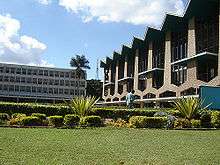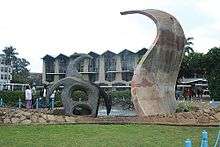University of Nairobi
 | |
| Motto |
Unitate et Labore In Unity and Work |
|---|---|
| Type | Public |
| Established |
1956 Royal Technical College 1961 Royal College Nairobi 1964 University College Nairobi 1970 University of Nairobi |
| Chancellor | Dr. Vijoo Rattansi |
| Vice-Chancellor | Prof. Peter Mulwa Felix Mbithi |
| Undergraduates | 49,488 |
| Postgraduates | 12,424 |
| Location |
Nairobi, Kenya 1°16′47″S 36°49′00″E / 1.27972°S 36.81667°ECoordinates: 1°16′47″S 36°49′00″E / 1.27972°S 36.81667°E |
| Campus | Urban |
| Affiliations | ACU |
| Website |
www |


The University of Nairobi (UoN) is a collegiate research university based in Nairobi. It is one of the largest universities in Kenya. Although its history as an educational institution dates back to 1956, it did not become an independent university until 1970. In this year, the University of East Africa was split into three independent universities: Makerere University in Uganda, the University of Dar es Salaam in Tanzania, and the University of Nairobi.
During the 2011 academic year, the university had 61,912 students, of whom 49,488 were undergraduates and 12,424 postgraduates. The university launched several policy frameworks and introduced self-funded enrollment (also called 'module 2') to cope with the rising demand for higher education in Kenya.[1]
Establishment
The inception of the University of Nairobi dates from 1956, with the establishment of the Royal Technical College, which admitted its first group of A-level graduates for technical courses in April the same year. The Royal Technical College was transformed into the second university college in East Africa on 25 June 1961 by the Scottish mathematician Prof James Morton Hyslop[2] formerly of the University of Witwatersrand under the name Royal College of Nairobi and was admitted into a special relation with the University of London whereupon it began preparing students in the faculties of Arts, Science and Engineering for award degrees of the University of London. Meanwhile, students in other faculties such as the Faculty of Special Professional Studies (later renamed Faculty of Commerce) and Faculty of Architecture continued to offer diplomas for qualifications of professional bodies/institutions.
On 20 May 1964, the Royal College Nairobi was renamed University College Nairobi as a constituent college of inter-territorial, Federal University of East Africa, and henceforth the enrolled students were to study for college degrees of the University of East Africa and not London as was the case before. In 1970, the University College Nairobi transformed into the first national university in Kenya and was renamed the University of Nairobi. The university tops in Kenya's university ranking and is ranked 7th in Africa and 1698 in the world according to Webometrics Ranking of World Universities.
History
The idea of an institution for higher learning in Kenya goes back to 1947 when the Kenya government drew up a plan for the establishment of a technical and commercial institute in Nairobi. By 1949, this plan had grown into a concept aimed at providing higher technical education for the African Great Lakes region. In September 1951, a Royal Charter was issued to the Royal Technical College of East Africa and the foundation stone of the college was laid in April 1952.
During the same period, the Asian Community of East Africa was also planning to build a college for Arts, Science and Commerce as a memorial to Mahatma Gandhi. To avoid duplication of efforts, Gandhi Memorial Academy Society agreed to merge interests with those of the East African Governments. Thus, the Gandhi Memorial Academy was incorporated into the Royal Technical College of East Africa in April 1954, and the college proceeded to open its doors to the first intake of students in April 1956.
Soon after the arrival of students at the college, the pattern of higher education in the African Great Lakes came under scrutiny. Through the recommendation of a working party formed in 1958, chaired by the Vice-Chancellor of the University of London, Sir John Lockwood, the Royal Technical College of East Africa was transformed. On 25 June 1961, the college became the second university college in East Africa, under the name "Royal College Nairobi."
The Royal College Nairobi was renamed "University College, Nairobi" on 20 May 1964. On the attainment of "University College" status, the institution prepared students for bachelor's degrees awarded by the University of London, while also continuing to offer college diploma programmes. The University College Nairobi provided educational opportunities in this capacity until 1966 when it began preparing students exclusively for degrees of the University of East Africa, with the exception of the Department of Domestic Science. With effect from July 1, 1970, the University of East Africa was dissolved and the three African Great Lakes countries set up their national universities. This development saw the birth of the University of Nairobi set up by an Act of Parliament.
Since 1970, the university grown from a faculty based university serving a student population of 2,768 to a college focused university serving over 68,000 students.
From a humble beginning as a technical college to the status of a major international teaching and research institution, the University of Nairobi has produced more trained human resources than any other' institution of higher learning in Kenya, with over 161,000 graduates to its credit.
Profile
The University of Nairobi is [3] a body corporate established under the Universities Act 2012 of the Laws of Kenya and the University of Nairobi Charter.
Through module II and III programmes, opportunity has been opened to thousands of Kenyans and foreigners, on a paying basis, who meet university admission requirements, but who have not been able to access university education due to restricted intake into the regular programmes that is determined by limited resource allocation by Government. In addition to the regular and evening and weekend programmes, classes are conducted at the University's Extra Mural Centres located at the country's county headquarters.
The university is admitting students to undertake courses in the proposed Koitalel Arap Samoei University College for law, business management and education courses that began in January 2015. This is a joint project of the County Government of Nandi and the University of Nairobi.
Colleges
The university underwent a major restructuring in 1983, resulting in decentralization of the administration, by creation of six colleges headed by principals. The following are the names and locations of the colleges:
- College of Agriculture and Veterinary Sciences
- College of Architecture and Engineering
- College of Biological and Physical Sciences
- College of Education and External Studies
- College of Health Sciences
- College of Humanities and Social Sciences
- Embu University College
Central Organs
The University has a number of common boards and centers that have specific mandates to facility the teaching and research functions. These organs are:
- Board of Postgraduate Studies (BPS)
- Board of Common Undergraduate Courses
- Center for International Programmes and Links (CIPL)
- Centre for Self Sponsored Programmes (CESSP)
- Quality Assurance
College of Education and External Studies
- School of Education
- School of Continuing and Distance Education
- Center for Open and Distance Learning (CODL)
- Kenya Science Campus
- Mombasa Campus Campus
- Kisumu Campus
Faculties/schools/centres/institutes
- African Women's Studies Centre
- Center for Sustainable Dryland Ecosystems and Societies
- Center of Open and Distance Learning
- Centre For Biotechnology & Bioinformatics
- Centre for Hiv Prevention And Research
- Centre for Urban Innovations
- Education For Change
- Faculty of Agriculture
- Faculty of Arts
- Faculty of Veterinary Medicine
- Institute for Climate Change and Adaptation]
- Institute For Development Studies
- Institute of Anthropology, Gender & African Studies
- Institute of Diplomacy and International Studies
- Institute of Nuclear Science & Technology
- Institute of Tropical & Infectious Diseases
- Kenya Science Campus
- Kisumu Campus
- Mombasa Campus
- Open,Distance and eLearning Centre
- Physical Sciences
- Population Studies And Research Institute
- School of Arts and Design
- School of Biological Sciences
- School of Business
- School of Computing and Informatics
- School of Continuing and Distance Education
- School of Dental Sciences
- School of Economics
- School of Education
- School of Engineering
- School of Journalism
- School of Law
- School of Mathematics
- School of Medicine
- School of Nursing
- School of Pharmacy
- School of Physical Science
- School of Public Health
- School of the Built Environment
- The Wangari Maathai Institute for Peace and Environmental Studies
Departments
- African Clothing and Footwear Research Network (ACFRN)
- African Women's Studies Centre
- Agricultural Economics
- Animal Production
- Arabic
- Architecture
- Biochemistry
- Business Administration
- Chemistry Department
- Civil and Construction Engineering
- Clinical Medicine and Therapeutics
- Clinical Studies
- Commercial Law
- Communication Skills and Studies
- Confucius
- Conservative and Prosthetic Dentistry
- Diagnostic Imaging & Radiation Medicine
- Distance Studies
- Education Administration and Planning
- Education Communication and Technology
- Education Studies
- Educational Foundations
- Electrical and Information Engineering
- Envrironmental and Biosystems Engineering
- Ethics and Research Committee
- Extra Mural Studies
- Finance & Accounting
- Finance Department
- Food Science, Nutrition and Technology
- French
- Geography
- Geology Department
- Geospatial and Space Technology
- History
- Human Anatomy
- Human Pathology
- Information Science
- Kiswahili
- Korean Studies
- Land Resource Management & Agricultural Technology
- Linguistics
- Literature
- Management Science
- Mechanical and Manufacturing Engineering
- Medical Microbiology
- Medical Physiology
- Meteorology
- Obstetrics & Gynaecology
- Ophthalmology
- Orthopaedic Surgery
- Paediatrics/Dentistry and Orthodontics
- Paedriatics
- Periodontology/Community and Preventive Dentistry
- Pharmaceutical Chemistry
- Pharmaceutics and Pharmacy Practice
- Pharmacology and Pharmacognosy
- Philosophy
- Physical Education and Sports
- Physics
- Plant Science and Crop Protection
- Political Science
- Private Law
- Psychiatry
- Psychology
- Public Health Pharmacology & Tox
- Public Law
- Real Estate and Construction Management
- Sociology
- Surgery
- Surgery, Oral Medicine/Pathology, Oral/Maxillofacial Radiology
- Translation
- Urban And Regional Planning
- Vet Farm
- Vet. Anatomy And Physiology
- Veterinary Pathology, Microbiology & Parasitology
Conferences and journals
Notable alumni
- Davis Chirchir, Cabinet Minister
- Ali Rasso Dido, National Assembly member
- Jacob Kaimenyi, Education Minister
- Michael Kamau, Cabinet Minister
- Felix Koskei, Cabinet Minister
- Joseph Ole Lenku, Cabinet Minister
- William Ruto, Deputy President
- Wangari Maathai, Nobel peace price laureate
- James Wainaina Macharia, Health Minister
- Fred Matiangi, Cabinet Minister
- Adan Mohammed, Cabinet Minister
- Musalia Mudavadi, Former Deputy Prime Minister and Former Vice-President
- Margaret Muthwii, Vice-Chancellor of Pan Africa Christian University
- Willy Mutunga, Former Chief Justice of Kenya
- John Nasasira, Ugandan Cabinet Minister
- Apolo Nsibambi, Prime Minister of Uganda
- James Orengo, Senator
- Henry Rotich, Finance Minister
- Anne Waiguru, Cabinet Minister
- Hassan Wario, Cabinet Minister
- Avril, singer and actress
- Maina Kiai, human rights activist and UN Special Rapporteur
- Wahu Kagwe, Singer actress songwriter entertainer
References
External links
- University of Nairobi official site
- Information About Kenyan Colleges and Universities
- Top colleges and universities in Kenya
- Private and public universities in Kenya
- University of Nairobi, Mombasa Campus